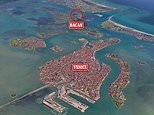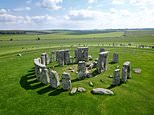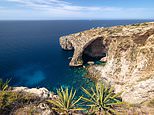The 'lost cities' that you can still visit: From Angkor Wat to Machu Picchu, spectacular ancient ruins that have defied the ages
- 'White City' in the Honduran Mosquitia jungle has just been discovered with the help of former British SAS soldiers
- The ancient city Machu Picchu is a tourist favourite, attracting one million visitors in the last year alone
- Founded 4,000 years ago, Babylon's mythic hanging gardens are considered one of the world's Seven Wonders
Rumoured to be hidden in the jungles of Honduras since the 16th century, the country's fabled White City has finally been discovered.
Buried deep in the remote La Mosquitia region, with its exact location kept secret to protect it from looters, the so-called 'lost city', whose inhabitants disappeared without a trace, is just one of the ruins around the world that give us a glimpse of another time.
The magnificent town of Machu Picchu, Peru, and the pumice rock-veiled ruins of Pompeii in Italy may be some of the most frequented among adventurers from around the world, there are plenty of lesser known sites that are just as breathtaking - and not nearly as busy.
From the ancient city of Babylon in Iraq, also home to the mythical hanging gardens that have been named one of the Seven Ancient Wonders of the World, to the medieval Armenian ruins of Ani, Turkey, these civilizations of yesteryear are nothing short of awe-inspiring.
MailOnline Travel has compiled a list of 10 must-visit 'lost cities,' guaranteed to satisfy everyone from history buffs to backpackers.
Scroll down for video

The 'city of Persians,' which lays at the foot of the Kuh-i-Ramat mountains, was once the ceremonial capital of the Achaemenid Empire


The Greeks burned a lot of the city to the ground when they invaded in 330 under the leadership of Alexander the Great
Persepolis, Iran
Persepolis, or 'the city of Persians,' dates back to 515 BC when it was once the ceremonial capital of the Achaemenid Empire.
Declared a UNESCO World Heritage Site in 1979, the ruins lie at the foot of Kuh-i-Rahmat, or Mercy Mountains, near the city of Shiraz.
It was built on a half-artificial, half-natural terrace where a palace complex inspired by Mesopotamian models was developed by cutting into the rocky mountainside.
All that remains today is that which was not burned by the Greeks in 330 under the leadership of Alexander the Great.

The ghost town of Epecuen, Argentina, may not be ancient, having flooded in 1985, but many former residents were sure it was lost forever
Epecuen, Argentina
This ghost town may not be ancient, but there was a time when many former residents were sure that it was lost forever.
Once a busting lakeside resort, the Argentinean town was flooded without warning in November 1985 when heavy rains caused the lagoon to burst its banks and submerged the small community in corrosive salt water.
Although the town was never rebuilt - most cafe owners and hoteliers simply moved to a nearby seaside town to set up shop - it's now become a popular tourist destination once again, in particular for the Jewish community of Buenos Aires.


Ciudad Perdida, located high in Colombia's Sierra Nevada mountains, has recently been dubbed 'the new Machu Picchu'
Ciudad Perdida, Colombia
High in the Sierra Nevada mountains, the country's Lost City has recently been dubbed 'the new Machu Picchu,' after being first discovered in the 1970s.
The site is believed to date back to about 800 AD, which is over 600 years earlier than the world's most famous lost city to which many comparisons have been drawn.
Made up of 169 terraces, which are carved into the mountains, Ciudad Perdida, or Teyuna as its known by the local tribes, also boasts early tiled roads and several small plazas.
However, to access the ruins, guests must be in good shape as they will be required to climb up 1,200 stone steps through dense jungle.

The 15th century Inca site of Machu Picchu is one of the world's most famous and offers several hiking options for daring trekkers
Machu Picchu, Peru
This 15th century Inca site is a tourist favourite among those interested in exploring ancient cities, attracting over one million visitors last year alone.
Adventurers can choose from one of several multi-day treks that lead hikers deep into the Sacred Valley, though the Inca Trail is far and away the most popular.
Coaches are also available for those who are unable to climb the 500-year-old citadel and still wish to take in the impressive views.
Tour operators recommend arriving at dawn or dusk for the most breathtaking views and warn that between 11am and 3pm is busiest.

The ancient city of Babylon in Iraq dates back 4,000 years when it was then the capital of 10 dynasties in Mesopotamia

Today, its walls and mythical hanging gardens are considered to be one of the Seven Ancient World Wonders
Babylon, Iraq
Founded 4,000 years ago, the ancient city was the capital of 10 dynasties in Mesopotamia, and its walls and mythic hanging gardens are considered to be one of the world's original Seven Wonders.
Also believed to be the birthplace of writing and literature, due to unrest in the region in recent years, Babylon has not drawn as many visitors as expected from the far reaches of the globe.
The city is located 85km south of Baghdad and is accessible only after going through several security checkpoints.
Where once stood towering gates and a bustling market city packed with traders, now only remains remnants of the city's walls and a 2,500-year-old statue of a lion.
The in-tact buildings at the ancient city are mainly ill-advised attempts by former dictator Saddam Hussein who tried to reconstruct monuments 'to glorify Iraq' and rebuilt the Nebuchadnezzar II palace on top of the original's ruins.

Angkor, in Southeast Asia, stretches over 400 square kms and offers remains of several different capitals of the Khmer Empire

Located in the Siem Riep Province, two of the site's most famous monuments are the Temple of Angkor Wat (pictured) and Bayon Temple
Angkor Wat, Cambodia
One of the most important archeological sites in Southeast Asia, Angkor stretches over 400 square kms and features the remains of several different capitals of the Khmer Empire.
All were constructed from between the 9th and 15th century, but the most famous are the Temple of Angkor Wat and the Bayon Temple.
The impressive monuments, ancient urban plans and large water reservoirs, as well as evidence of centuries-old communication routes, are all located in the Siem Reap Province and are indicative of an exceptional civilization.

The historical city of Petra is famous for its opulent architecture, which was carved into the region's red sandstone rock
Petra, Jordan
The historical city, located in the Ma'an governorate, is famous for its architecture, carved into the red sandstone rock, as well as for its ancient water conduit system.
Ideally situated between the Red Sea and the Dead Sea, Petra was once an important crossroads between Arabia, Egypt and Syria-Phoenicia.
The surrounding mountains are riddled with passages and gorges, though the UNESCO World Heritage Centre is subject to erosion due to wind, including windblown sand, and rain.

The ancient Roman town of Pompeii, Italy, was buried by burning pumice stone in 79 AD after Mount Vesuvius erupted
Pompeii, Italy
The ancient Roman town is situated near the current city of Naples, and researchers believe that it was founded as early as six century BC.
However, the impressive architecture was mostly buried and destroyed after the eruption of Mount Vesuvius in 79 AD blanketed the region in burning pumice stone and ash.
Today, the ghostly ruins, which include an amphitheatre and a port, are one of the most popular tourist destinations in the country, drawing 2.5 million guests each year.

The medieval Armenian ruins of Ani, Turkey, are situated in Kars, near the Akhurian River on the border of Armenia

Once a walled city with more than 100,000 residents, in the centuries that followed, the region was conquered many times
Ani, Turkey
The medieval Armenian ruins are situated in Kars, near the Akhurian River on the border of Armenia, and was once the capital of the Bagratid Armenian Kingdom.
Once a walled city with more than 100,000 residents, in the centuries that followed, the region was conquered many times - by everyone from Ottoman Turks to Russians - and was completely abandoned by the 1700s.
One of its most famous monuments is the Monastery of the Hripsimian Virgins, which was thought to be built between 1000 and 1200 AD.
Most watched News videos
- Scottish woman has temper tantrum at Nashville airport
- Tesla Cybertruck explodes in front of Trump hotel in Las Vegas
- Mass panic as New Orleans attacker flies down Bourbon street
- Shocking moment zookeeper is fatally mauled by lions in private zoo
- Horrific video shows aftermath of New Orleans truck 'attack'
- Meghan Markle celebrates new year in first Instagram video
- Tesla Cybertruck burns outside Trump hotel in Las Vegas
- See how truck that drove into crowd made it through police barrier
- Cheerful Melania Trump bops to YMCA at Mar-a-Lago NYE bash
- New Orleans terror attack suspect reveals background in video
- Plane passenger throws drink at flight attendant in boozy fight
- Horrifying moment yacht crashes into rocks and sinks off Mexico coast










































Better hurry up to see them as ISIS is on the way ...
by Jay Edwards 65